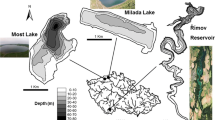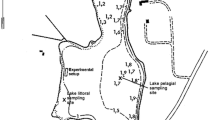Abstract
The golden mussel Limnoperna fortunei is a freshwater bivalve that adheres to water intake facilities, leading to problems of several kinds. Biofouling problems have been increasing recently in East Asia and South America, and the planktonic stage of this species is considered to play an important role in its dispersal. We investigated the larval dynamics of L. fortunei in two reservoirs, Lake Ohshio and Lake Takenuma, which are connected by a headrace channel. An aeration system for water quality conservation was present in the former reservoir but not in the latter. Larval density in Lake Ohshio was more than 10,000 individuals/m3 with a maximum of 80,000 individuals/m3 in summer. The density in Lake Takenuma was much lower, with a maximum of around 200 individuals/m3. Water temperature (WT) and dissolved oxygen (DO) concentration were almost uniform regardless of water depth in Lake Ohshio because of destratification due to continuous aeration. Summer WT and DO in the lake were considered to be suitable for survival and reproduction of L. fortunei. On the other hand, stratification was found for WT and DO in Lake Takenuma throughout the summer. The low WT and DO found in the deep areas of the lake in summer were considered to be not suitable for survival and reproduction of this species. Thus, the population of L. fortunei larvae differed widely even in two adjoining lakes, and WT and DO are considered to be critical factors, especially for reproduction.






Similar content being viewed by others
References
Antenucci JP, Ghadouani A, Burford MA, Romero JR (2005) The long-term effect of artificial destratification on phytoplankton species composition in a subtropical reservoir. Freshw Biol 50:1081–1093
Boltovskoy D, Correa N, Cataldo D, Sylvester F (2006) Dispersion and ecological impact of the invasive freshwater bivalve Limnoperna fortunei in the Rio de la Plata watershed and beyond. Biol Invasions 8:947–963
Borcherding J, De Ruyter Van Steveninck ED (1992) Abundance and growth of Dreissena polymorpha larvae in the water column of the River Rhine during downstream transportation. In: Neumann D, Jenner HA (eds) The Zebra Mussels Dreissena polymorph. Gustav Fischer, New York, pp 29–44
Brönmark C, Hansson LA (2005) The biology of lakes and ponds, 2nd edn. Oxford University Press, Oxford
Burford MA, O’Donohue MJ (2006) A comparison of phytoplankton community assemblages in artificially and natural mixed subtropical water reservoirs. Freshw Biol 51:973–982
Cataldo D, Boltovskoy D (2000) Yearly reproductive activity of Limnoperna fortunei (Bivalvia) as inferred from the occurrence of its larva in the plankton of the lower Parana River and the Rio de la Plata estuary (Argentina). Aquat Ecol 34:307–317
Cowell BC, Dawes CJ, Gardiner WE, Scheda SM (1987) The influence of whole lake aeration on the limnology of a hypereutrophic lake in central Florida. Hydrobiologia 148:3–24
Darrigran G (2002) Potential impact of filter-feeding invaders on temperate inland freshwater environments. Biol Invasions 4:145–156
Darrigran G, Maronas ME, Colautti DC (2004) Air exposure as a control mechanism for the Golden Mussel, Limnoperna fortunei, (Bivalvia: Mytilidae). J Fresh Ecol 19:461–464
Darrigran G, Damborenea C, Greco N (2007) An evaluation pattern for antimacrofouling procedures: Limnoperna fortunei larvae study in a hydroelectric power plant in South America. Ambio 36:575–579
Fraleigh PC, Klerks PL, Gubanich G, Matisoff G, Stevenson RC (1993) Abundance and settling of zebra mussel (Dreissena polymorpha) veligers in Western and Central Lake Erie. In: Nalepa TF, Schloesser DW (eds) Zebra Mussels, biology, impacts and control. Lewis, London, pp 129–142
Heo WM, Kim B (2004) The effect of artificial destratification on phytoplankton in a reservoir. Hydrobiologia 524:229–239
Horvath TG, Lamberti GA, Lodge DM, Perry WL (1996) Zebra mussel dispersal in lake-stream systems: source-sink dynamics? J North Am Benthol Soc 15:564–575
Iwasaki K (1997) Climbing behavior and tolerance to aerial exposure of a freshwater mussel, Limnoperna fortunei. Venus 56:15–25
Karatayev AY, Padilla DK, Minchin D, Boltovskoy D, Burlakova LE (2007) Changes in global economics and trade: the potential spread of exotic freshwater bivalves. Biol Invasions 9:161–180
Katayama M, Shimizu R, Matsumoto H (2005) The first record of Limnoperna fortunei (Bivalvia, Mytilidae) in Gunma. Field Biol 14:35–40 (in Japanease)
Mackie GL, Gibbons WN, Muncaster BW, Gray IM (1989) The zebra mussel, Dreissena polymorpha: a synthesis of European experiences and a preview for North America: report prepared for the Ontario Ministry of the Environment, Water Resources Branch. Great Lakes Section, Toronto
Magara Y, Matsui Y, Goto Y, Yuasa A (2001) Invasion of the non-indigenous nuisance mussel, Limnoperna fortunei, into water supply facilities in Japan. J Water Supply 50:113–124
Matsui Y, Nagaya K, Yuasa A, Naruto H, Yamamoto H, Ohkawa K, Magara Y (2001) Attachment strength of Limnoperna fortunei on substrates, and their surface properties. Biofouling 17:29–39
McClintock NL, Wilhm J (1977) Effects of artificial destratification on zooplankton of two Oklahoma reservoirs. Hydrobiologia 54:233–239
Montalto L, Drago IE (2003) Tolerance to desiccation of an invasive mussel, Limnoperna fortunei (Dunker, 1857) (Bivalvia, Mytilidae), under experimental conditions. Hydrobiologia 498:161–167
Morton B (1977) The population dynamics of Limnoperna fortunei (Dunker 1857) (Bivalvia: Mytilacea) in Plover Cove reservoir, Hong Kong. Malacologia 16:165–182
Nagaya K, Matsui Y, Ohira H, Yuasa A, Yamamoto H, Ohkawa K, Magara Y (2001) Attachment strength of an adhesive nuisance mussel, Limnoperna fortunei, against water flow. Biofouling 17:263–274
Newell RIE, Hilbish TJ, Koehn RK, Newell CJ (1982) Temporal variation in the reproductive cycle of Mytilus edulis L (Bivalvia, Mytilidae) from locations on the east coast of the United States. Biol Bull 162:299–310
Newell CR, Hidu H, McAlice BJ, Podniesinski G, Short F, Kindblom L (1991) Recruitment and commercial seed procurement of the blue mussel Mytilus edulis in Maine. J World Aquacult Soc 22:134–152
Nishimura T, Habe T (1987) Contamination of Chinese freshwater bivalves in imported freshwater clams. Chiribotan (News reports of the Malacological Society of Japan) 18:110–111 (in Japanese)
Paolucci EM, Cataldo DH, Fuentes CM, Boltovskoy D (2007) Larvae of the invasive species Limnoperna fortunei (bivalve) in the diet of fish larvae in the Parana River, Argentina. Hydrobiologia 589:219–233
Ricciardi A (1998) Global range expansion of the Asian mussel Limnoperna fortunei (Mytilidae): another fouling threat to freshwater systems. Biofouling 13:97–106
Riessen HP, Ferro TA, Kamman RA (1993) Distribution of zebra mussel (Dreissena polymorpha) veligers in Eastern Lake Erie. In: Nalepa TF, Schloesser DW (eds) Zebra Mussels, biology, impacts and control. Lewis, London, pp 143–152
Sherman B, Whittington J, Oliver R (2000) The impact of artificial destratification on water quality in Chaffey Reservoir. Arch Hydrobiol 55:15–29
Stich HB, Lampert W (1981) Predation evasion as an explanation of diurnal vertical migration by zooplankton. Nature 293:396–398
Stoeckel JA, Rehmann DW, Schneider DW, Padilla DK (2004) Retention and supply of zebra mussel larvae in a large river system: importance of an upstream lake. Freshw Biol 49:919–930
Sylvester F, Boltovskoy D, Cataldo D (2007) Fast response of freshwater consumers to a new trophic resource: predation on the recently introduced Asian bivalve Limnoperna fortunei in the lower Parana river, South America. Austral Ecol 32:403–415
Wetzel RG (2001) Limnology, 3rd edn. Academic, San Diego
Wielgosz S (1983) Effects of artificial destratification on zoobenthos and on the trophic status of a Polish reservoir. Hydrobiologia 102:197–203
Acknowledgments
D.N. thanks Dr. Yasuyuki Nogata and Dr. Noriyuki Endo for helpful advice with regard to this paper. We thank Hiroshi Matsumoto, Hideo Kanai, Masahiro Nomura, Yumi Nagao, members of the group for green management of Lake Ohshio, and Tatsuhisa Horikoshi and his family for help with the investigations. We also thank Tomioka City and Fujioka City for providing us with the use of their facilities.
Author information
Authors and Affiliations
Corresponding author
Rights and permissions
About this article
Cite this article
Nakano, D., Kobayashi, T. & Sakaguchi, I. Differences in larval dynamics of golden mussel Limnoperna fortunei between dam reservoirs with and without an aeration system. Landscape Ecol Eng 6, 53–60 (2010). https://doi.org/10.1007/s11355-009-0082-7
Received:
Revised:
Accepted:
Published:
Issue Date:
DOI: https://doi.org/10.1007/s11355-009-0082-7




